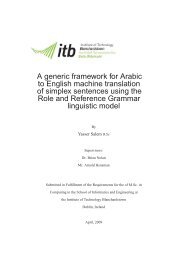On the occurrence and consequences of inaccurate ... - Acsu Buffalo
On the occurrence and consequences of inaccurate ... - Acsu Buffalo
On the occurrence and consequences of inaccurate ... - Acsu Buffalo
Create successful ePaper yourself
Turn your PDF publications into a flip-book with our unique Google optimized e-Paper software.
274 E.R. Odders-White / Journal <strong>of</strong> Financial Markets 3 (2000) 259}286<br />
demonstrate that this does not explain <strong>the</strong> relation between "rm size <strong>and</strong><br />
misclassi"cation. After dividing <strong>the</strong> sample into transactions inside <strong>and</strong> at<br />
<strong>the</strong> quotes, <strong>the</strong> probability that large stocks' transactions are misclassi"ed<br />
continues to exceed that <strong>of</strong> small stocks for both subsamples (35.42%<br />
vs. 28.78% inside <strong>the</strong> spread <strong>and</strong> 11.33% vs. 3.67% at <strong>the</strong> quotes). Similarly,<br />
although "rm size <strong>and</strong> trading frequency are highly correlated, <strong>the</strong> statistics in<br />
Table 4 Panel E demonstrate that large stocks are misclassi"ed more <strong>of</strong>ten even<br />
after controlling for trading frequency. Consequently, more frequent trading<br />
cannot fully explain <strong>the</strong> association between "rm size <strong>and</strong> misclassi"cation.<br />
(Likewise, "rm size does not drive <strong>the</strong> increased misclassi"cation associated with<br />
frequent trading.)<br />
The results in Tables 3 <strong>and</strong> 4 demonstrate that <strong>the</strong> Lee <strong>and</strong> Ready method<br />
misclassi"es transactions at <strong>the</strong> spread midpoint <strong>and</strong> transactions in large or<br />
actively traded stocks most frequently. In addition, small transactions at <strong>the</strong><br />
quotes <strong>and</strong>, to a much lesser extent, large transactions inside <strong>the</strong> spread are<br />
problematic. Some <strong>the</strong>oretical justi"cation for <strong>the</strong>se "ndings has been presented,<br />
but questions about <strong>the</strong> cause still remain.<br />
It is clear that price improvement is at <strong>the</strong> root <strong>of</strong> <strong>the</strong> problem. Although we<br />
<strong>of</strong>ten think <strong>of</strong> price improvement as trades executing inside <strong>the</strong> spread, orders<br />
executing at <strong>the</strong> opposite quote (buying at <strong>the</strong> bid <strong>and</strong> selling at <strong>the</strong> ask) is<br />
simply a more extreme case <strong>of</strong> price improvement. In this sense, trades that are<br />
more likely to be misclassi"ed are simply those that are more likely to receive<br />
some form <strong>of</strong> price improvement. For example, perhaps transactions in large<br />
"rms are misclassi"ed more <strong>of</strong>ten due to price improvement stemming from less<br />
uncertainty (e.g. more analysts following <strong>the</strong> stock) or more liquidity provision<br />
(e.g. #oor traders).<br />
<strong>On</strong>e <strong>of</strong> <strong>the</strong> ways in which misclassi"cation results from price improvement is<br />
examined in Fig. 4. The "gure describes a common case <strong>of</strong> midpoint-trade<br />
misclassi"cation. In this scenario, <strong>the</strong>re is no change in <strong>the</strong> execution price <strong>and</strong><br />
<strong>the</strong> spread widens (<strong>the</strong> bid decreases <strong>and</strong> <strong>the</strong> ask remains <strong>the</strong> same or <strong>the</strong> ask<br />
increases <strong>and</strong> <strong>the</strong> bid remains <strong>the</strong> same). In <strong>the</strong> example, <strong>the</strong> initial bid <strong>and</strong> ask<br />
Fig. 4. Midpoint misclassi"cation.<br />
When <strong>the</strong> analysis was repeated using only <strong>the</strong> Lee <strong>and</strong> Radhakrishna subsample, <strong>the</strong> results<br />
were equally as strong or stronger, with two exceptions. Using <strong>the</strong>ir subsample, time between<br />
transactions is no longer a statistically signi"cant determinant <strong>of</strong> misclassi"cation <strong>and</strong> large trades<br />
are misclassi"ed slightly more frequently than small trades (7.2% vs. 5.7%).
















